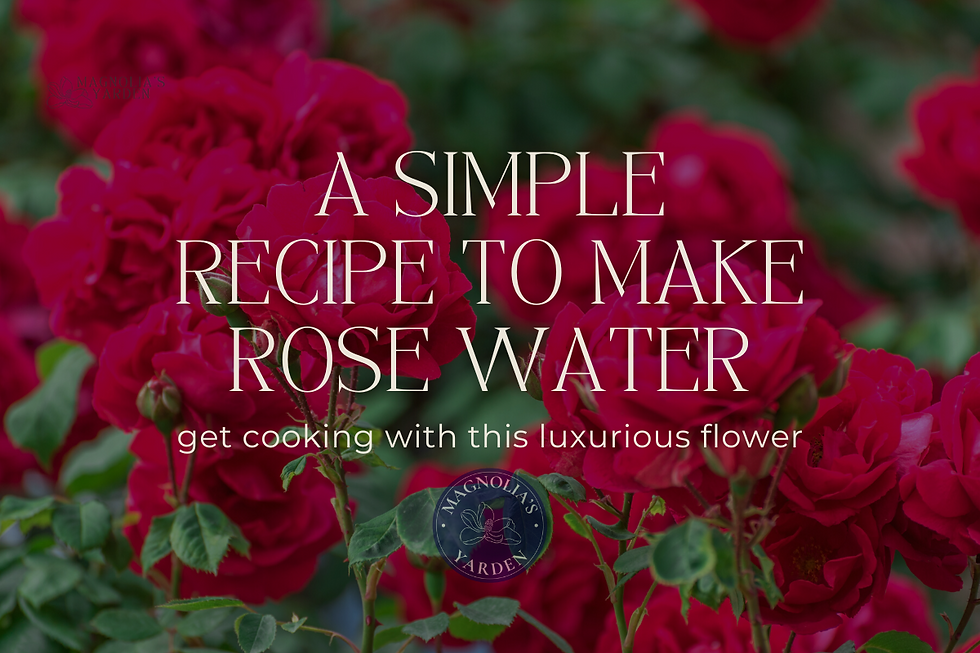Are Edible Flowers Safe to Eat?
- Magnolia's Yarden
- Jun 1
- 4 min read
What You Need to Know Before Adding Blooms to Your Plate
Edible flowers are undeniably beautiful—but are edible flowers safe to eat? At Magnolia’s Yarden, we believe nature belongs on your plate only when it’s safe. Whether you’re a chef drizzling petals on panna cotta or a parent garnishing birthday cupcakes, knowing what’s safe (and what’s not) is essential.
Let’s bloom with confidence. Here’s what you need to know before turning flowers into food and edible flower food safety.

This guide is here to offer clarity, backed by both practical knowledge and our years of hands-in-the-soil experience growing gourmet edible flowers for chefs, bakers, florists, and food lovers across California and beyond.
Are edible flowers safe to eat? Not All Flowers Are Created Equal
Let’s begin with the essential truth: not all flowers are edible. While some varieties are celebrated for their flavor and safety, others—though beautiful—can be toxic. Foxglove, lily of the valley, and delphinium are just a few examples of flowers that should never be consumed or come into contact with food. Even edible flowers can pose risks if they’re sprayed with pesticides, fungicides, or floral preservatives meant for visual—not culinary—use.
This is why we urge our community to never use store-bought bouquets or landscape flowers in food or drink, unless they are specifically labeled as edible and organically grown for that purpose.
That’s why we grow our blooms with culinary use in mind. Every edible flower from Magnolia’s Yarden is grown on our microfarm without the use of harmful sprays and harvested at its peak for maximum freshness and flavor.
Toxic Flowers Shortlist
Foxglove (Digitalis purpurea)
Contains cardiac glycosides (digitoxin, digitoxigenin), which can disrupt heart rhythm and be potentially fatal with even small ingestion.
Lily of the Valley (Convallaria majalis)
Every part contains potent cardiac glycosides. Ingesting gelatinous berries or leaves can cause nausea, vomiting, irregular heartbeat, and potentially lead to death.
Oleander (Nerium oleander)
One of the most toxic garden shrubs—contains cardiac glycosides similar to foxglove. Even a single leaf can induce severe heart disturbances.
Rhododendron / Azalea (Rhododendron spp., Azalea spp.)
Contains grayanotoxins that affect heart and nerve function. Symptoms include nausea, weakness, low blood pressure, and arrhythmias.
Delphinium (Larkspur)
Garden larkspur has neurotoxic alkaloids. Especially dangerous to children and pets—can cause muscle weakness, paralysis, and respiratory failure.
Daffodil
Bulbs and blooms contain lycorine. Ingestion causes vomiting, diarrhea, and abdominal cramps.
Hydrangea
Contains cyanogenic glycosides that release cyanide. It can trigger nausea, vomiting, and rarely convulsions.
Ranunculus a.k.a. Buttercup (Ranunculus spp.)
Contains ranunculin, which becomes irritating protoanemonin when crushed. Causes blistering of the mouth and digestive upset.
Bleeding Heart (Lamprocapnos spectabilis)
All parts are toxic and contain isoquinoline alkaloids. Results may include nausea, vomiting, breathing difficulty, and seizures.
Autumn Crocus (Colchicum autumnale)
Contains colchicine. Highly toxic—causes gastrointestinal distress, multi‑organ failure, and death.
Calla Lily (Zantedeschia spp.)
Contains insoluble calcium oxalate crystals. Ingestion causes severe irritation of the mouth and throat, accompanied by swelling and pain.
Anemone (Anemone spp.)
Contains protoanemonin—irritating to mucous membranes. Ingestion causes nausea, vomiting, and potential respiratory distress.
Bakers and cake artists: even if a toxic flower fits your wedding or event theme beautifully, it’s best to avoid using it—especially when children or guests might assume everything on the plate is edible. And to brides, DIYers, and hosts: please consider steering clear of these potentially dangerous blooms to keep your loved ones safe and confident that what’s on their slice is truly safe to enjoy.

Safe-to-Eat Flowers: A Few Favorites
Here are a few of the edible flowers we grow and recommend with confidence:
Nasturtium
Peppery, vibrant blooms and leaves add bold flavor and color to salads and savory dishes.
Pansy / Viola
Mildly grassy sweetness; colorful petals perfect for decorating cakes and desserts.
Calendula / Pot Marigold (Calendula officinalis)
Slightly bitter petals with saffron-like color—used in soups, salads, and teas.
Borage
Cucumber‑flavored blue star‑shaped petals are a nutritious garnish for summer drinks and salads.
Chamomile (Chamaemelum nobile)
Floral and apple‑like, often steeped in tea or used to flavor desserts.
Rose
Sweet, aromatic petals and rose hips—used in syrups, jellies, and confections.
Lavender
Floral and slightly herbaceous—ideal for syrups, teas, cookies, and desserts.
Lilac (Syringa vulgaris)
Delicate and perfumed, petals can be used fresh or infused into syrups for added flavor.
Chive blossoms
Mild onion flavor; great in savory dishes, compound butters, or as a garnish.
Basil blossoms
Soft herbaceous petals—subtle basil aroma and flavor paired with salads and cocktails.
Sunflower petals
Mild and nutty petals (remove the tough center)—used in salads or floral décor.
Cornflower
Mild flavor and bright blue color, often used raw in salads or blended with butter.
Each variety is grown on our microfarm, utilizing thoughtful soil practices and prioritizing food safety. For a complete list of edible flowers grown by Magnolia’s Yarden →
Tips for Safely Enjoying Edible Flowers
Always source from a trusted grower (like us!) who grows specifically for culinary use
Wash gently and pat dry before use
Avoid unknown flowers unless positively identified as edible
Start with small amounts if trying a variety for the first time
If you’re unsure, ask! We’re always happy to guide you on safe and flavorful flower use.
Edible flowers are more than beautiful—they’re flavorful, seasonal, and endlessly creative. But safety should always come first. At Magnolia’s Yarden, we grow with care so you can plate with confidence. Whether you’re styling a cake, shaking up a cocktail, or dressing a salad, our blooms are meant to be savored.
Ready to try safe, stunning blooms?
Happy cooking with flowers!
~ Danielle
❀ Live your best botanical life from the garden to the kitchen! ❀
.png)





Comments